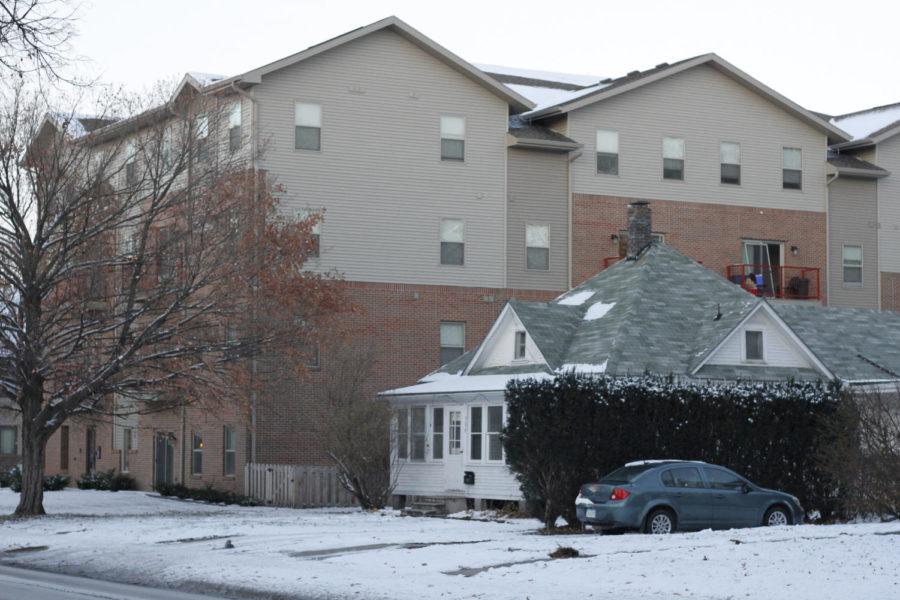Enrollment increases strain student, Ames resident housing relations
The residential neighborhood of Campustown draws in a number of students as well as non-students. The neighborhood is situated just south of campus.
December 2, 2014
The city of Ames has seen problems arise in recent years because of an increasing influx of students. Those problems extend past campus and impact the neighborhoods of Ames.
Neighborhoods in Ames range in definition. Some areas have neighborhood associations that are registered with the city of Ames, while other areas do not.
“Neighborhoods in Ames are essentially self-defined. It’s up to the people who live there to identify their neighborhood and what the boundaries are, so we have quite a range,” said Jeff Benson, planner and neighborhood liaison for the Department of Planning and Housing in Ames.
Some Ames residents are living in high-density areas, while others are living in low-density areas with fewer people. This differential helps define the neighborhoods of Ames.
“Neighborhoods might be defined by zoning in some cases because you find a high-density zone near a low-density zone,” said Gloria Betcher, Ames councilwoman. “The people in the low-density zone congregate together and the people in the high-density zone congregate together, but we also have mixed neighborhoods.”
Belcher said one factor in defining Ames neighborhoods that can be agreed upon is the want for a higher quality of life.
“They want to be safe,” Betcher said. “They want to enjoy the outdoor spaces of their neighborhood as well as their own homes.”
Neighborhoods have seen changes because of the addition of 7,000 students in the past three years. The addition of large apartment buildings among the single-family homes has changed the landscape of some neighborhoods.
An example is 601 State Ave., which was recently rezoned to low-density residential by the City Council.
The Breckenridge Group LLC currently owns the parcel of land and had originally requested that the area be zoned Floating Suburban Residential Medium in order to build more units on the 29-acre parcel of land.
The new zoning is a specific change to the city’s land use policy plan. The change in the plan satisfies the concerns of neighborhood residents who have voiced those concerns in past meetings.
By zoning the south parcel of land as low-density residential, the developer is unable to build as many bedrooms on the land as they previously planned.
Residents spoke at multiple city council meetings about problems that a large number of residents, mostly students, moving to the area may cause. These concerns included congested traffic, problems in the environment of the green space around the area, and an increased amount of students with a largely different pattern of living than the single families in the area.
“There are studies that have been done that show very clearly that student living patterns are very different from the living patterns of families,” Betcher said. “The hours that are kept are different, the amount of emphasis on social activity can be different, the number of trips in a car can be different”.
One solution to the problem could include relocating where developers want to build. By changing locations from single-family neighborhoods to parts of town where large student housing buildings are already in place, many problems could be bypassed in terms of rezoning.
Benson explained by moving developments to West Ames, specifically the area west of the Ames Middle School on Mortensen Road, a more smooth transition could be seen because of the high population of students in the immediate area.
The differences in living patterns have Betcher wondering what can be done to solve the problems that arise when students live near single families.
The One-Eighty Community Initiative is a plan drafted by Betcher to search for a solution to the problem. The plan would attempt to reach three goals:
1) Identify the immediate needs of the community.
2) Outline steps to address those needs and bring about a 180-degree turnaround in our trend toward divisive relations.
3) Work to maintain the healthy relationships developed and capitalize on those relationships to benefit not only the residents — student and permanent alike — but also the city of Ames and Iowa State organizations.
The plan can be put into action by the university and the city, as opposed to a city commission.
“The One Community Board… would be designed to address ongoing, long-term concerns related to integrating students and permanent residents into a unified community, a much slower, continuing process that requires the support of both the city and the university,” Betcher said.







